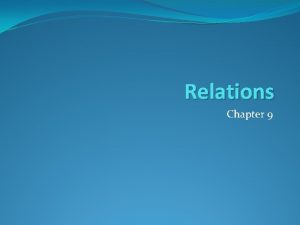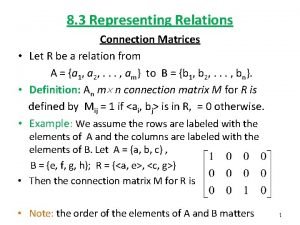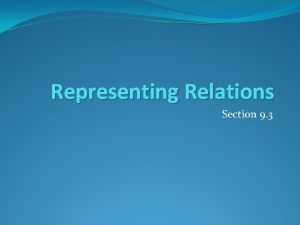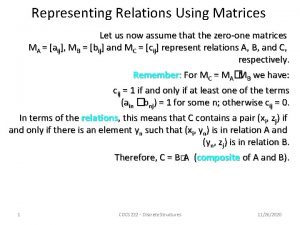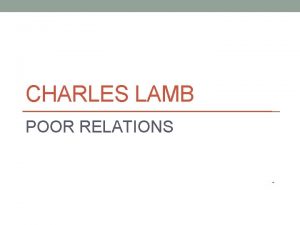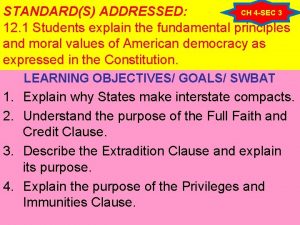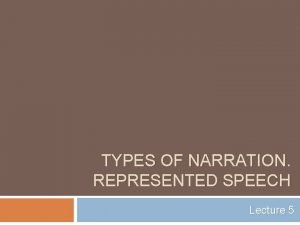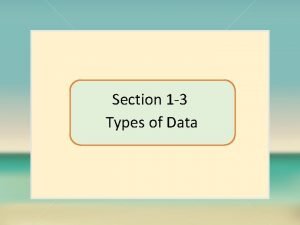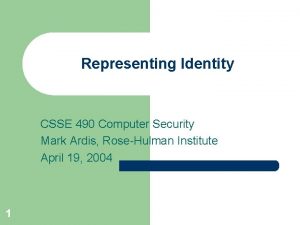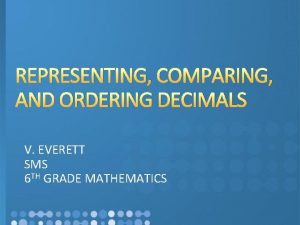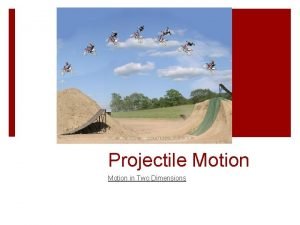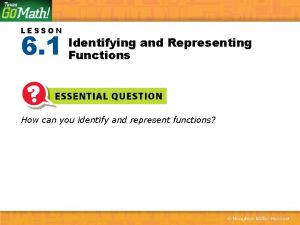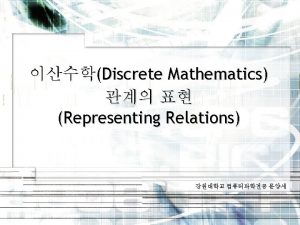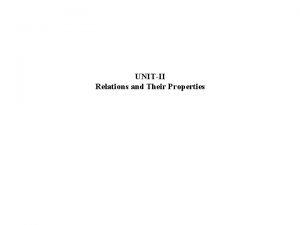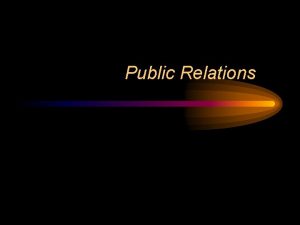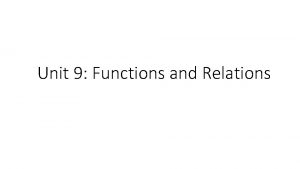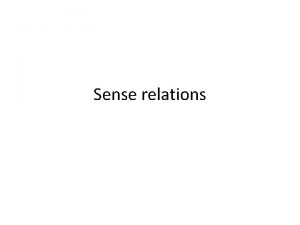Representing Relations Section 9 3 Section Summary Representing














- Slides: 14

Representing Relations Section 9. 3

Section Summary �Representing Relations using Matrices �Representing Relations using Digraphs

Representing Relations Using Matrices �A relation between finite sets can be represented using a zero-one matrix. �Suppose R is a relation from A = {a 1, a 2, …, am} to B = {b 1, b 2, …, bn}. �The elements of the two sets can be listed in any particular arbitrary order. When A = B, we use the same ordering. �The relation R is represented by the matrix MR = [mij], where �The matrix representing R has a 1 as its (i, j) entry when ai is related to bj and a 0 if ai is not related to bj.

Examples of Representing Relations Using Matrices Example 1: Suppose that A = {1, 2, 3} and B = {1, 2}. Let R be the relation from A to B containing (a, b) if a ∈ A, b ∈ B, and a > b. What is the matrix representing R (assuming the ordering of elements is the same as the increasing numerical order)? Solution: Because R = {(2, 1), (3, 2)}, the matrix is

Examples of Representing Relations Using Matrices (cont. ) Example 2: Let A = {a 1, a 2, a 3} and B = {b 1, b 2, b 3, b 4, b 5}. Which ordered pairs are in the relation R represented by the matrix Solution: Because R consists of those ordered pairs (ai, bj) with mij = 1, it follows that: R = {(a 1, b 2), (a 2, b 1), (a 2, b 3), (a 2, b 4), (a 3, b 1), (a 3, b 3), (a 3, b 5)}.

Matrices of Relations on Sets �If R is a reflexive relation, all the elements on the main diagonal of MR are equal to 1. � R is a symmetric relation, if and only if mij = 1 whenever mji = 1. R is an antisymmetric relation, if and only if mij = 0 or mji = 0 when i≠ j.

Example of a Relation on a Set Example 3: Suppose that the relation R on a set is represented by the matrix Is R reflexive, symmetric, and/or antisymmetric? Solution: Because all the diagonal elements are equal to 1, R is reflexive. Because MR is symmetric, R is symmetric and not antisymmetric because both m 1, 2 and m 2, 1 are 1.

Representing Relations Using Digraphs Definition: A directed graph, or digraph, consists of a set V of vertices (or nodes) together with a set E of ordered pairs of elements of V called edges (or arcs). The vertex a is called the initial vertex of the edge (a, b), and the vertex b is called the terminal vertex of this edge. � An edge of the form (a, a) is called a loop. Example 7: A drawing of the directed graph with vertices a, b, c, and d, and edges (a, b), (a, d), (b, b), (b, d), (c, a), (c, b), and (d, b) is shown here.

Examples of Digraphs Representing Relations Example 8: What are the ordered pairs in the relation represented by this directed graph? Solution: The ordered pairs in the relation are (1, 3), (1, 4), (2, 1), (2, 2), (2, 3), (3, 1), (3, 3), (4, 1), and (4, 3)

Determining which Properties a Relation has from its Digraph �Reflexivity: A loop must be present at all vertices in the graph. �Symmetry: If (x, y) is an edge, then so is (y, x). �Antisymmetry: If (x, y) with x ≠ y is an edge, then (y, x) is not an edge. �Transitivity: If (x, y) and (y, z) are edges, then so is (x, z).

Determining which Properties a Relation has from its Digraph – Example 1 a c b d • Reflexive? No, not every vertex has a loop • Symmetric? Yes (trivially), there is no edge from one vertex to another • Antisymmetric? Yes (trivially), there is no edge from one vertex to another • Transitive? Yes, (trivially) since there is no edge from one vertex to another

Determining which Properties a Relation has from its Digraph – Example 2 a c b d • Reflexive? No, there are no loops • Symmetric? No, there is an edge from a to b, but not from b to a • Antisymmetric? No, there is an edge from d to b and b to d • Transitive? No, there are edges from a to b and from b to d, but there is no edge from a to d

Determining which Properties a Relation has from its Digraph – Example 3 a c b d Reflexive? No, there are no loops Symmetric? No, for example, there is no edge from c to a Antisymmetric? Yes, whenever there is an edge from one vertex to another, there is not one going back Transitive? Yes, there is edge from a to b that is required.

Determining which Properties a Relation has from its Digraph – Example 4 a c b d • Reflexive? No, there are no loops • Symmetric? No, for example, there is no edge from d to a • Antisymmetric? Yes, whenever there is an edge from one vertex to another, there is not one going back • Transitive? Yes (trivially), there are no two edges where the first edge ends at the vertex where the second edge begins
 Symmetric relation
Symmetric relation Representing relations using digraphs
Representing relations using digraphs Symmetric relation
Symmetric relation Representing relations using digraphs
Representing relations using digraphs Employee relations in public relations
Employee relations in public relations Poor relations by charles lamb text
Poor relations by charles lamb text Why might states feel the need to form compacts
Why might states feel the need to form compacts Chapter 4 section 3
Chapter 4 section 3 Inner represented speech
Inner represented speech It consists of numbers representing counts or measurements.
It consists of numbers representing counts or measurements. Mark ardis
Mark ardis Representing comparing and ordering decimals
Representing comparing and ordering decimals Draw vector arrows representing the vx and vy brainly
Draw vector arrows representing the vx and vy brainly Nejime floral design
Nejime floral design Identify and representing functions
Identify and representing functions
